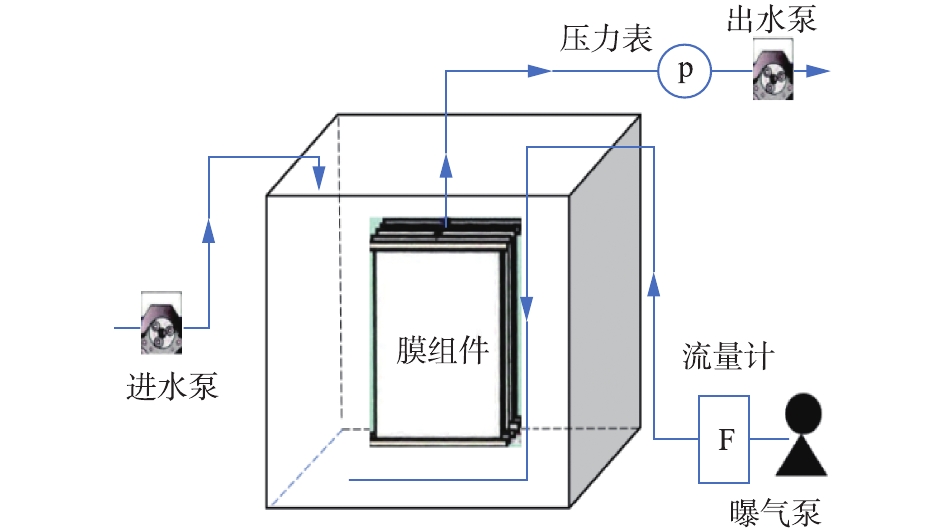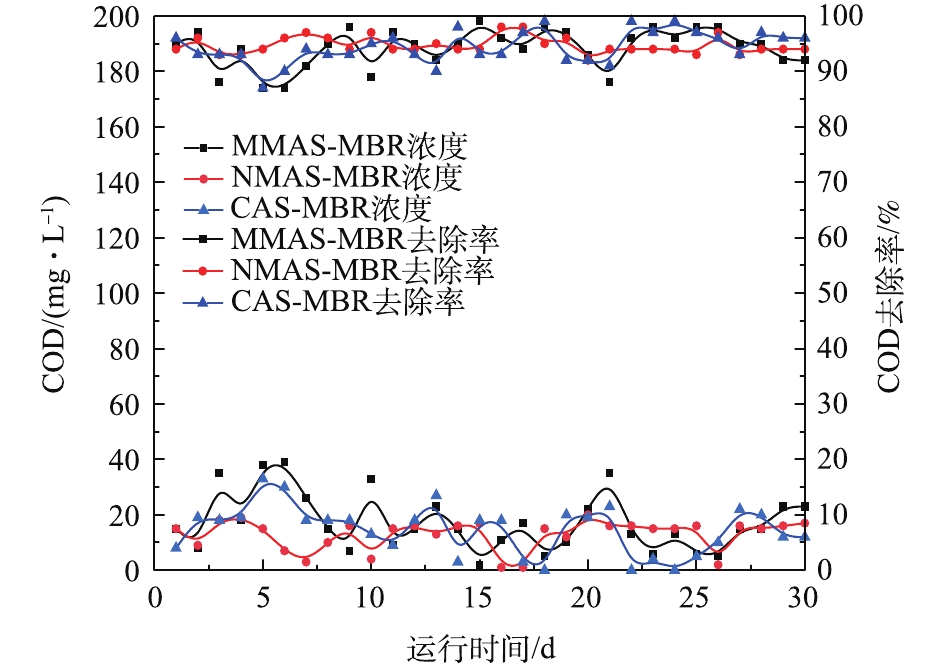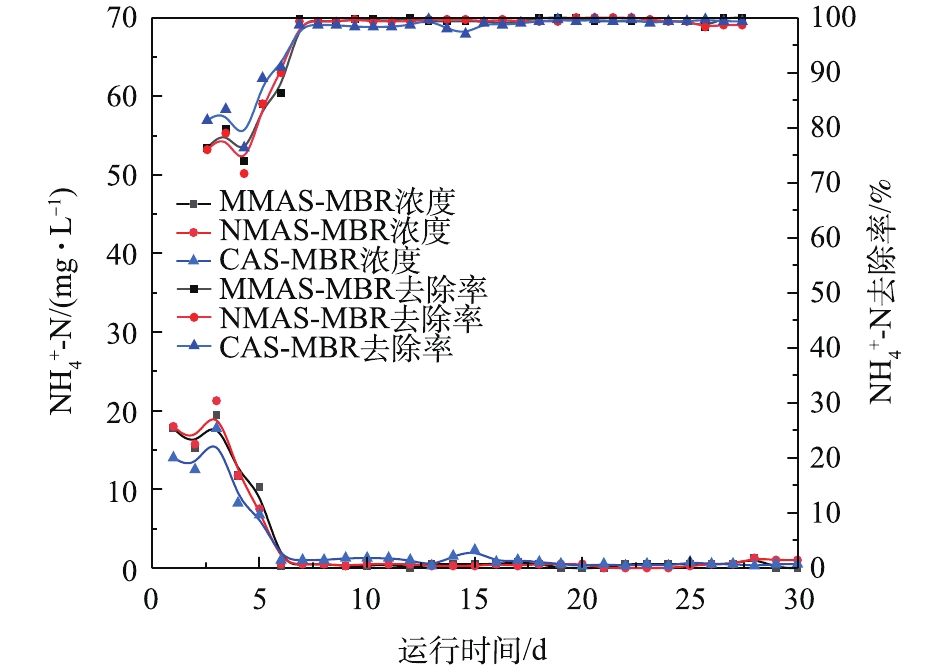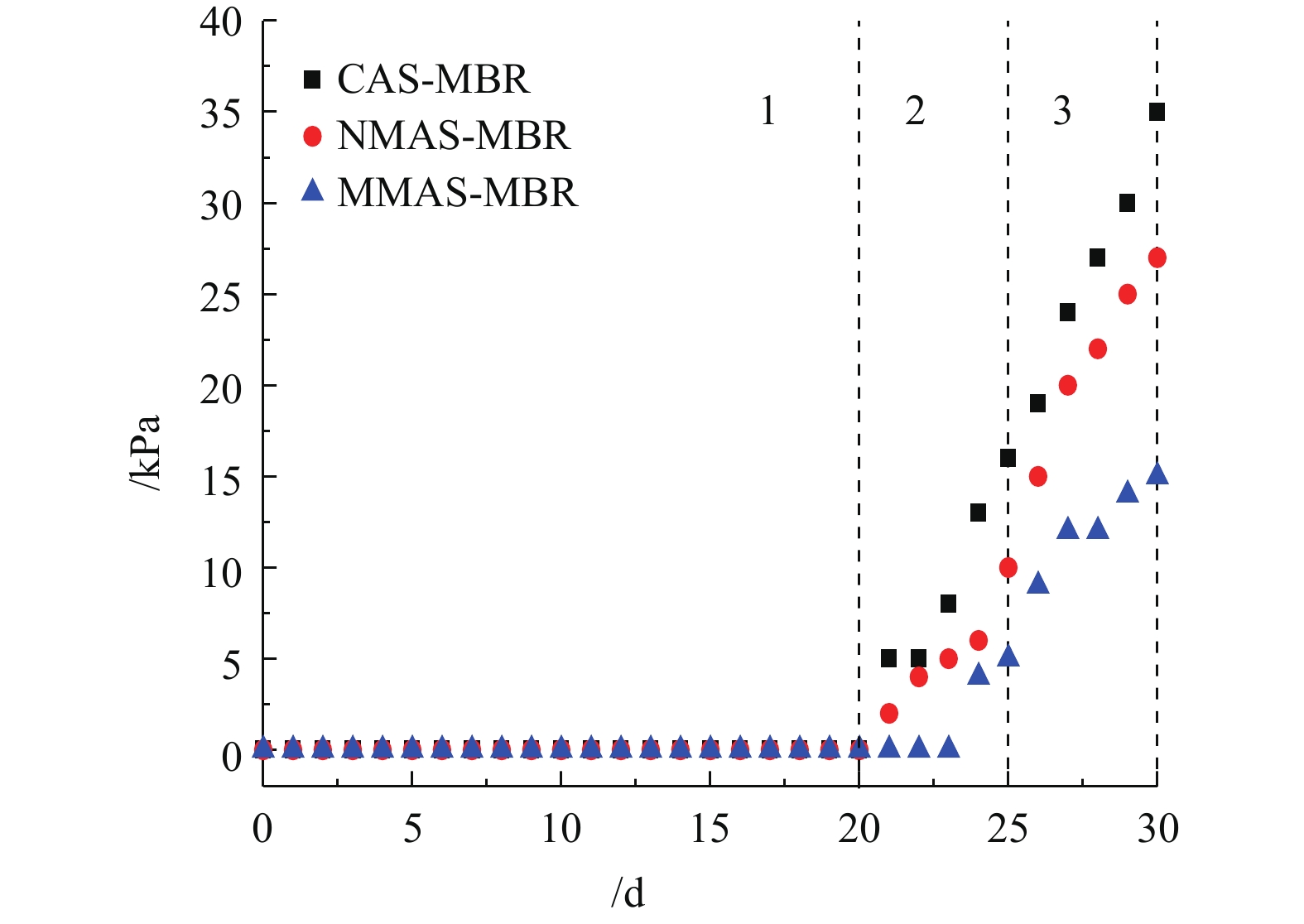-
膜生物反应器(membrane bio-reactor, MBR)是近年来迅速发展起来的既能控制水体污染又能实现污水资源化的新型污水处理技术,被公认为水处理领域最具有发展潜力的高新技术之一,受到了广泛关注,并已被广泛用于市政和工业废水处理与回用领域[1-3]。但是,膜污染导致的通量衰减、运行成本增加等问题仍是制约其大规模应用的瓶颈[4-7],至今仍是MBR研究与应用中的热点和难点。
磁性材料因其生物兼容性良好,已在生物处理工艺中得到了广泛的关注和研究,近来的研究发现磁性材料在延缓MBR膜污染、改善膜通量方面也显示出了巨大潜力[8-10]。并且磁性材料具有磁响应特性,可以通过分离、活化后进行循环使用,经济可行性好。但是,在采用磁性材料适宜粒径的研究方面,研究人员[11-12]得到了不同甚至相悖的结论,因而有必要系统研究微纳米磁性粒子对MBR运行效能的影响。
本研究拟通过对比研究微纳米磁性粒子对MBR系统运行效能的影响,包括污染物去除效果、污泥混合液特性、膜污染情况等,并基于高通量测序、生物信息分析等方法,深入分析微纳米磁性粒子引入后微生物群落演替规律与MBR运行效能的关联,以期为磁活性污泥法应用于MBR膜污染控制领域提供参考。
全文HTML
-
实验采用的MBR装置为3套实验室规模的膜生物反应器(见图1),有效容积为4.5 L。膜组件购自天津膜天膜科技股份有限公司生产的中空纤维膜,其基本参数为膜丝内外直径分别为0.85 mm/1.0 mm,膜孔径0.1 μm,膜材质为聚偏氟乙烯(PVDF)。
3套MBR系统水力停留时间设置为8 h,膜组件下设有曝气管,曝气强度为0.3 m3·h−1。通过时间继电器控制蠕动泵,实现间歇抽吸出水,出水方式为9 min开/3 min停。膜的运行通量为15 L·(m2 h)−1。由真空表记录跨膜压差(transmembrane pressure,TMP)的变化,当其数值上升到35 kPa时,停止运行,对膜组件进行离线化学清洗。实验所用磁粉购自国药试剂(中国),主要成分为四氧化三铁(Fe3O4)。
-
实验用水为人工模拟生活污水,组成浓度分别为葡萄糖175 mg·L−1,淀粉175 mg·L−1,氯化铵300 mg·L−1,磷酸二氢钾52.8 mg·L−1,碳酸钠700 mg·L−1,氯化钙8 mg·L−1,七水硫酸镁9 mg·L−1,硫酸铁0.3 mg·L−1。
-
进出水中COD和
$ {\rm{NH}}_{\rm{4}}^{\rm{ + }}$ -N采用哈希DRB200消解器和DR3900分光光度计及相关试剂测定,蛋白质采用BCA法测定,多糖采用蒽酮-硫酸法[13]测定。EPS分为SMP、松散型胞外多聚物(LB-EPS)以及固着型胞外多聚物(TB-EPS) 3部分,采用改进的热提取法[14]提取。 -
为了对比研究微生物群落的演替规律,定期从3套MBR系统中采集污泥样品。即无磁粉添加的对照组MBR(CAS-MBR),添加了1 g·L−1磁性微米Fe3O4的MBR(MMAS-MBR),添加了1 g·L−1磁性纳米Fe3O4的MBR系统(NMAS-MBR)。对污泥样品进行DNA提取、PCR扩增、Illumina MiSeq测序以及生物信息分析。
1.1. 实验装置及运行条件
1.2. 实验用水
1.3. 常规分析方法
1.4. 分子生物学分析
-
实验期间,CAS-MBR、MMAS-MBR、NMAS-MBR 3套系统的COD去除效果如图2所示。可以看出,进水COD为200~550 mg·L−1时,3套系统出水COD均低于50 mg·L−1,达到了国家污水排放标准一级A标准(GB 18918-2002)。这可能是MBR工艺本身的特性保障了良好的有机污染物去除效果,既有活性污泥法高效的生物降解功能,又兼具膜的高效截留作用。这也从侧面表明了微纳米磁性粒子的引入并未对MBR系统去除有机污染物的效能造成负面影响。
CAS-MBR、MMAS-MBR、NMAS-MBR 3套系统的
$ {\rm{NH}}_{\rm{4}}^{\rm{ + }}$ -N去除效果如图3所示。从实验中可以看出,由于$ {\rm{NH}}_{\rm{4}}^{\rm{ + }}$ -N去除过程中起主要作用的硝化类细菌生长较缓慢,启动初期(前5 d),出水$ {\rm{NH}}_{\rm{4}}^{\rm{ + }}$ -N均维持在5 mg·L−1以上。随着硝化类细菌由于膜的截留作用在反应器内得到逐步富集,从第6天开始,$ {\rm{NH}}_{\rm{4}}^{\rm{ + }}$ -N去除效果得到了显著提升并趋于稳定。进水$ {\rm{NH}}_{\rm{4}}^{\rm{ + }}$ -N为30~90 mg·L−1时,3套系统运行稳定后,出水$ {\rm{NH}}_{\rm{4}}^{\rm{ + }}$ -N均维持在2 mg·L−1以下,去除率均维持在95%以上。这也从侧面表明了微纳米磁性粒子的引入并未对MBR系统去除$ {\rm{NH}}_{\rm{4}}^{\rm{ + }}$ -N的效能造成负面影响。 -
实验过程中3套MBR系统均以恒流量模式运行,以TMP指标来表征膜污染情况。当TMP达到35 kPa时,将膜组件取出进行离线清洗。
图4反映了CAS-MBR、MMAS-MBR、NMAS-MBR 3套系统的TMP随时间的变化情况。为了缩短实验周期,分3个阶段运行。第1阶段(1~20 d),膜运行通量均为13.2 L·(m2·h)−1;第2阶段(21~24 d),膜运行通量均提升到15 L·(m2·h) −1;第3阶段(25~30 d),膜运行通量均提升到18 L·(m2·h) −1。从图4可以看出:在第1阶段,由于膜通量较低,对应的膜污染速率均较低,3套系统TMP增加均较缓慢;在第2阶段和第3阶段,随着膜运行通量的提升,3组MBR系统膜污染速率均加快,膜污染趋势依次为CAS-MBR>NMAS-MBR>MMAS-MBR。在本实验结束时的第30天,CAS-MBR、NMAS-MBR、MMAS-MBR的TMP分别为35、27、15 kPa。可见,微纳米磁性粒子的引入均可有效减缓膜污染情况,并且相对纳米尺度磁性材料,微米尺度的磁性材料膜污染延缓效果更显著,这可能与纳米材料引起的纳米损伤有关。原因为:微纳米磁性粒子的磁生物效应改变了反应器内微生物群落结构及其代谢活动,并且随着运行时间的延长,磁生物效应的作用越显著,膜通量之间的差异也越来越大。
实验期间,对比分析了CAS-MBR、MMAS-MBR和NMAS-MBR中SMP和LB-EPS的组成和含量,如图5所示。由图5可看出,相比对照组CAS-MBR、MMAS-MBR和NMAS-MBR,系统中SMP的多糖和蛋白质含量均有所降低。分子质量分析结果显示,大分子物质比例显著降低(图6),而LB-EPS的多糖和蛋白质含量与之相当,甚至有所增加。结合图4中的膜污染情况,可以推测,反应器中较高浓度的SMP及较高大分子物质的比例更易加剧膜污染。BANTI等[15]的研究结果证实了膜孔内SMP的逐渐沉积和聚集会加剧膜污染。进一步对比分析发现,NMAS-MBR系统中SMP、LB-EPS各组分含量整体上高于MMAS-MBR,并且SMP中大分子物质比例也显著高于MMAS-MBR(图6),因而NMAS-MBR系统的膜污染速率也显著高于MMAS-MBR,这可能与纳米材料引起细胞纳米损伤,从而释放更多内溶物(膜污染物质)有关。通过对比膜污染各组分,发现多糖含量占比较高,这与MENG等[16]的研究一致。
-
生物反应器性能的变化通常是由微生物群落结构的改变引起的。因此,本实验按时间取样,从CAS-MBR、MMAS-MBR、NMAS-MBR系统中分别取样,编号为CAS_5、CAS_10、CAS_15、CAS_20;MAS_5、MAS_10、MAS_15、MAS_20、MAS_25、MAS_30;NAS_5、NAS_10、NAS_15、NAS_20、NAS_25、NAS_30。基于高通量测序、生物信息分析等方法,对比分析微纳米磁性粒子引入后微生物群落的演替规律,进一步探讨其与MBR系统运行效能的关系。3套MBR系统不同时段种群丰度与微生物多样性指数如表1所示。Chao指数显示,添加磁性颗粒的MBR系统中的种群丰度呈增长趋势。Shannon指数显示,对照组CAS-MBR系统的菌落多样性随运行时间延长而减少,而添加磁性颗粒MMAS-MBR和NMAS-MBR系统的菌落多样性基本保持不变,这将显著提高生物系统耐受环境突变或者抗冲击负荷的能力,有利于保障系统的稳定性。
由图7(a)可以看出,Proteobacteria在所有样本中丰度最高,与之前的报道[17-18]一致。在CAS-MBR、NMAS-MBR、MMAS-MBR系统中,Proteobacteria分别占总有效序列的39.77%~55.22%、30.71%~50.78%、24.82%~49.75%。与对照组CAS-MBR相比,添加磁性颗粒后,实验初期,Proteobacteria和Chloroflexi的种群丰度与之处于同等水平,然而,随着时间的延续,NMAS-MBR、MMAS-MBR系统中Proteobacteria和Chloroflexi的种群丰度逐渐降低,这可能与膜污染速率降低有关。由图7(b)可知,对照组CAS-MBR系统中,Alphaproteobacteria随着时间的延续,种群丰度依次增加;NMAS-MBR系统中,Alphaproteobacteria前期处于同等丰度水平,后期丰度则显著增加,但仍低于同期CAS-MBR丰度;MMAS-MBR系统中,Alphaproteobacteria前期丰度水平较低,中期丰度与NMAS-MBR相当,后期丰度则显著低于同期CAS-MBR、NMAS-MBR。我们之前的研究已证实膜污染可能与来源于反应器中的先锋物种有关[19],结合图4中的膜污染情况,可以推测Alphaproteobacteria可能是引起膜污染的主要种属,而磁性材料的引入对反应器中的Alphaproteobacteria起到了抑制作用,进而延缓了膜污染,并且微米尺度的磁性材料抑制效果优于纳米尺度。在生物处理过程中,Sphingobacteria是富含糖原积累生物的核心菌,能够降解几丁质和蛋白质[20]。在CAS-MBR系统中,可以看出,后期Sphingobacteria丰度较MMAS-MBR和NMAS-MBR系统下降较为明显。此外,在CAS-MBR系统中,与Bacteroidetes门类有关的Flavobacteriia的相对丰度较NMAS-MBR和MMAS-MBR系统下降也较为明显。结合压力变化,可以推测Sphingobacteria和Flavobacteriia可能有利于大分子的降解,而磁性材料的引入促进了这2类菌属的生长,进而延缓了膜污染。
-
由于微纳米磁性材料具有可回收利用、生物兼容性好等特性,可以在保障MBR污染物去除效能的同时减轻膜污染,缓解膜污染导致的通量衰减、运行成本增加等问题,经济效益显著。主要原因如下:1)微纳米磁性材料具有较大的比表面积,可以吸附污泥混合液中易引起膜污染的蛋白质、多糖等物质,在一定程度上可减缓膜污染;2)微纳米磁性材料具有一定的生物絮凝功能,使污泥絮体结构更加密实,污泥沉降性能大大提高,反应池内有效生物量增加,污染物去除效果和抗冲击负荷能力增强;3)磁致生物效应,磁场强度适宜时可增强微生物活性、减少剩余污泥产生,保障污染物去除效能;4)微纳米磁性材料可以通过磁分离器从污泥中分离、再活化、循环利用,使运行成本降低,同时分离磁粉后的污泥成分和常规剩余污泥类似,避免了投加絮凝剂产生大量难处理的化学污泥,经济上可行,实际操作简单。
2.1. 污染物去除效能
2.2. 膜污染情况
2.3. 微生物多样性分析
2.4. 经济效益分析
-
1)相对于CAS-MBR系统,微纳米磁性粒子的引入均未在污染物去除方面产生负面影响,3套MBR系统出水COD都低于50 mg·L−1,出水
$ {\rm{NH}}_{\rm{4}}^{\rm{ + }}$ -N维持在5 mg·L−1以下,均可达到国家污水排放标准一级A标准(GB 18918-2002)。2)相对于CAS-MBR系统,微纳米磁性粒子的引入均有效降低了膜污染速率,并且相对纳米尺度磁性材料,微米尺度的磁性材料膜污染延缓效果更显著。
3)膜污染组分分析表明,相对于CAS-MBR系统,MMAS-MBR、NMAS-MBR系统中SMP和LB-EPS各组分含量均有所降低;相对于MMAS-MBR,NMAS-MBR系统SMP各组分含量与之相当,而LB-EPS各组分含量较高,因而膜污染速率较高;分子质量分析表明,磁性材料的引入可有效减少反应器中大分子物质的比例,增加小分子物质的比例,有利于膜污染的减缓。
4)微生物群落分析表明,磁性材料的引入显著改变了系统中微生物群落的结构和组成,进而引起了污泥混合液特性的变化,继而影响膜污染进程,因此,磁活性污泥法可以作为控制MBR膜污染的可行且实用的方法。






 下载:
下载:







